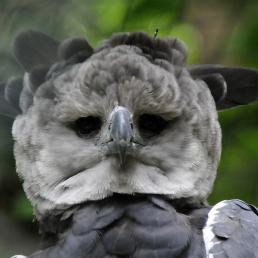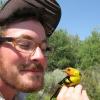

Join BirdNote tomorrow, November 30th!
Illustrator David Sibley and actor H. Jon Benjamin will face off in the bird illustration battle of the century during BirdNote's Year-end Celebration and Auction!
Dawn was just breaking as we sped by Bellingham. I stared out the window, trying to quell my anxiety. Bald Eagles held sentry over every field, and rain was imminent. Sodden gray clouds made it impossible to tell that the North Cascades arched just to the east. Chasing vagrant birds makes me anxious.
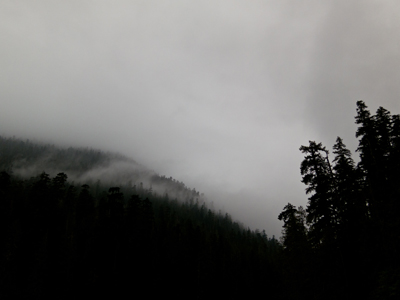
I have inconsistent luck finding vagrants. I say “vagrants” specifically instead of “rare birds,” because plenty of birds considered rare may also be resident. Reviewing my American Birding Association list (a list of birds, vagrant or otherwise, confirmed and seen in the contiguous US, Canada, and Alaska), I was mostly reminded of past failures. For some reason, the worst culprits seemed to be ducks and gulls. These are big, hardy birds, fairly easy to see. So how in the world could I expect to see two birds that would fit in one of my back pockets?
Dashing off to see a bird, whether it’s a vagrant from Asia or simply an unusual occurrence for your state or county, is a time-honored tradition in the birding world. We spend lots of money to see them, too. People drive and fly countless miles, spending hours – even days – standing in wait or circling suspicious looking bushes, searching for birds. The ABA (American Birding Association) even has a scale by which to rate species occurrence. With codes ranging from 1 to 6 (1 are regularly occurring; 6 are birds that cannot be found, e.g., those extinct or extirpated), the vagrants of the day were a 3 (Rare) and a 4 (Casual).
However, to be quite honest, birding by numbers makes me cringe.
I find chasing birds unromantic, fairly unintellectual, and resource guzzling. I also dislike the value system it places on an order of vertebrates that are all of worth and interest. Yet, I am still compelled to do it, because I have a twisted love of seeing rare or unusual species.
While I was mulling this over, my parents and I crossed the border into Canada. My parents are not ardent birders, but they enjoy seeing birds more than your average person, and we enjoy going on trips together. In fact, over the course of my adolescence, they were downright indulgent of my passion for birds. Who uses their hard-earned American vacation time to take their kid on a birding trip to Southern Texas?
Our directions were very specific. Drive to Queens Park in New Westminster, a sleepy suburb of Vancouver, British Columbia. Once there, walk to the playground and shuffle around until you see the bird.
Bird one was a Code 4. A small, old-world flycatcher with red flanks and a blue tail. It had yet to make an appearance that day, so we shuffled around, squinting in the understory of second-growth Douglas fir with the rest of the rabble there at 8 AM on a Sunday. The bird has a very descriptive name, the Red-flanked Bluetail (Tarsiger cyanurus). And for people who really don’t get birding, this won’t make any sense at all: I’d seen one before.
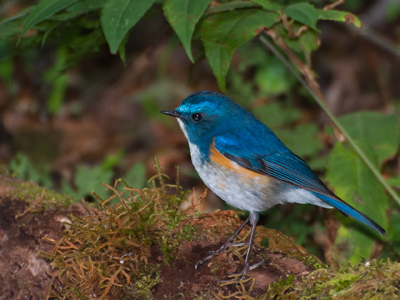
But not in North America, and that was the crux of it. The last time I’d seen one was on top of the tallest mountain in Thailand, Doi Inthanon, where they winter. I was anxious to see it here and understandably nervous that we might have driven 130 miles for nothing. I wanted it for my ABA list, not just my life list (the total list of species I’ve seen in my life). Happily, unlike quite a few other occasions, we managed to see the bird within twenty minutes of our arrival. The weight on my shoulders was lifted.
We followed it around for an hour, watching it flit about the understory, just as I’d seen them do in Thailand. This little female bird, though not as striking as the males I'd seen, was pleasantly adorned with reddish flanks and a blue tail. And she seemed totally at home here. After all, it’s a bird that breeds in Northern Eurasia and winters in the more temperate regions of Southern Asia. While I had my doubts about it returning there to breed, I expected that, unlike some birds that show up in strange places (like a Summer Tanager that showed up in Seattle in December 2012), it was hardy enough to survive.
The second bird, less of a priority and rated only as a 3, was just up the road in Vancouver. True to the oddity of vagrant birds, it was in a residential alleyway. Also a bird I’d seen before (but in Ireland), this was a stunning Eurasian finch called a Brambling (Fringilla montifringilla).
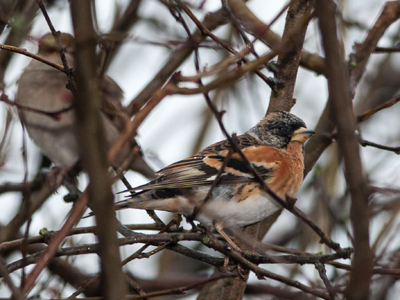
As with the bluetail, seeing the Brambling was a breeze. We drove up, got out of the car, walked into the alleyway, and there it was. Another northerly bird, it seemed totally at home, happily sharing a tangle of bushes with our native sparrows and finches. Maybe it was glad to have some company, being a rather gregarious bird found in flocks of thousands in its normal range. By the time we left, a group of birders had gathered, gushing over the Brambling and oblivious to the rain and the dingy alleyway.
My parents and I didn’t do a lot more birding that day, but made quick stops to see Snowy Owls along Boundary Bay and then in the Skagit Valley to see a Gyrfalcon. Both are birds many birders have never seen, especially if they're not from the northern tier of states. We drove over 300 miles that day to see all this, and some might call this odd.
And really, it’s all too easy to flaunt how strange the world of birding is, but I do it all the same. However, I’ll never be convinced that seeing a bird far from home, out of place, is more exciting than seeing it in its natural habitat. Chasing vagrant birds is a detached extrapolation of studying birds and while I may sneer at it, if it makes people get excited about and care for birds and nature, I’m a fan.
